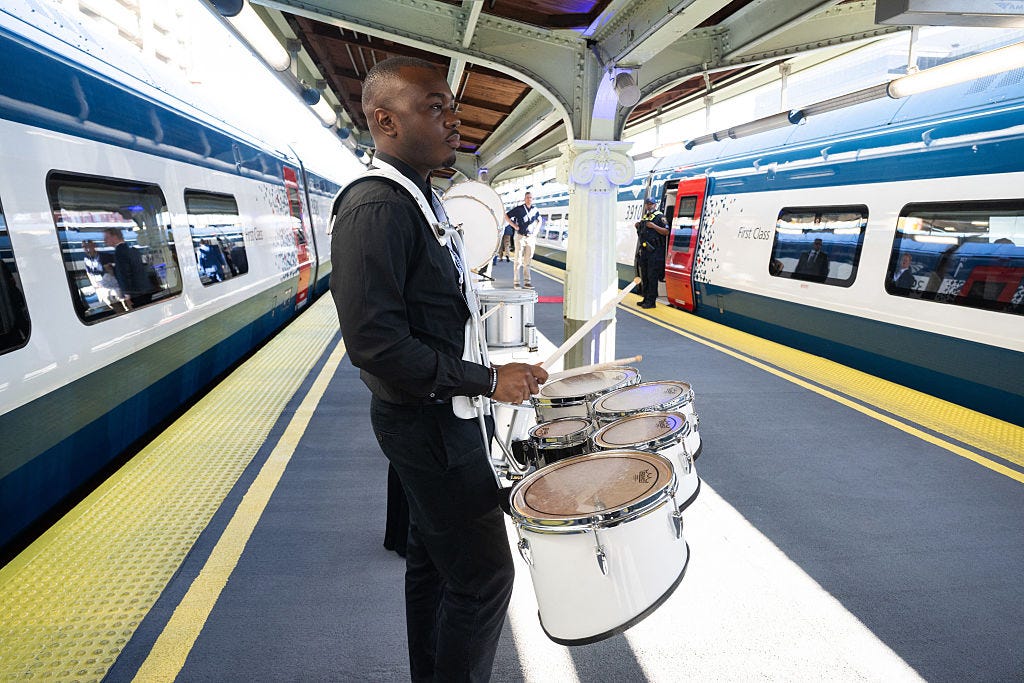Abundance Is a Vehicle For Community
Why investing in infrastructure can bolster a healthy liberalism.

Just so you know: In addition to this column, Francis Fukuyama also writes for the main Persuasion mailing list. That means that if you don’t subscribe to Persuasion, you might miss out on receiving some of his essays!
Click here to manage your account and toggle on the button to receive emails for Persuasion. And as ever, thank you for supporting our community.
I mentioned in a recent post that liberalism’s detractors charge that it doesn’t provide for community, but that that accusation overlooks the possibilities for community in the form of a thriving civil society. Moreover, the republican tradition anchored liberalism in a substantive understanding of civic virtue. This type of liberalism was not indifferent to the way of life chosen by citizens. People are not simply atomized individuals seeking their own betterment or that of their families, though that is certainly allowed. There should be a presumption that they are also citizens who maintain an active role in self-government, and who participate as fully as they can in public life. What liberalism enjoins is not moral assertions or community built around them. Rather, it says that there cannot be one single moral standard enforced on the whole of society.
This vision of a public-spirited citizenry originally arose out of the New England town hall meeting, where citizens gathered to deliberate over local issues. But we have a big problem of scale. Today’s United States has a population of 340 million; citizen participation at such a scale on issues of national significance is very hard to imagine. Among other things, large scale promotes the professionalization of civil society. There are many civil society organizations in the United States today representing a wide range of passions and interests. But organizations like the American Association of Retired Persons (AARP) have millions of members. They rely on professional organizers to carry out these objectives. Participation is often limited to paying regular dues and reading occasional newsletters.
Moreover, there is an unhealthy form of civil society in which people participate in interest groups whose primary function is either rent-seeking, or else are dedicated to extremist causes and political combat. Civic virtue requires a minimum amount of civility, a willingness to deliberate under the assumption that others taking part are acting in good faith and want to solve a common problem.
So here’s a suggestion for killing two birds with one stone. Build civic life around infrastructure projects. Infrastructure is intrinsically related to the public good: roads, airports, electrical grids, and wind farms all serve a broad community interest. But infrastructure is also rooted in particular places. Though there are some infrastructure projects that span multiple jurisdictions and affect millions of people, like power transmission lines, the vast majority of projects are locally based. The beneficiaries and stakeholders generally live in a single community.
Building infrastructure inevitably requires democratic governance and active citizen participation. While most projects can be considered public goods, their construction always injures the narrow interests of certain stakeholders who must give up right of way, experience disruption during construction, or suffer changes to the environment in which their communities are located. This balancing of collective and private interests is something that cannot be settled technocratically; it preeminently requires an exercise of democratic self-government to balance the different interests and priorities in the community.
Moreover, the United States today faces a huge deficit in infrastructure, with trillions of dollars of backlog of needed investments in maintaining the systems we already have, like our roads and bridges. But building new things can be a source of community pride and action. The Apollo moon landing program of the 1960s served as a concrete focus for the national community and there have been no projects of a similar scale attempted since then. Franklin Roosevelt’s New Deal administration began with a series of ambitious building projects, like the Tennessee Valley Authority, Hoover Dam, and the Golden Gate bridge, all of which were rolled out in the space of a few years. A new national focus on infrastructure would have to eliminate many of the accumulated procedural rules that make New Deal-style projects impossible today, while keeping an eye on the objectives of those rules.
We already inject mechanisms for public participation in formulating infrastructure projects, but in many cases participation becomes an end in itself and highly committed stakeholders become over-represented at the expense of collective interests like speed and efficiency. But the act of making such decisions can be seen not simply as a necessary exercise of choice, but also a school for citizenship in which community members learn to play active roles in deliberation. Deliberation over building a desalination plant or a wind farm or a new road can become controversial, but unlike some cultural issues like abortion or transgender rights, may not yet have been sucked into the vortex of the polarized national debate. It would also create a point of accountability for major decisions that are typically lost in the broader political struggle.
Thus stronger community and citizenship can pave the way for necessary infrastructure, while infrastructure can help to build community. This is one potential way out of our current dilemma, in which we are polarized between two extremes: a procedural fetish and vetocracy that prevents anything from being built, and an authoritarian government that wants to bypass all rules and act through fiat. A healthy new liberalism needs to find a middle path by which it can build things once again.
Francis Fukuyama is the Olivier Nomellini Senior Fellow at Stanford University. His latest book is Liberalism and Its Discontents. He is also the author of the “Frankly Fukuyama” column, carried forward from American Purpose, at Persuasion.
Follow Persuasion on X, LinkedIn, and YouTube to keep up with our latest articles, podcasts, and events, as well as updates from excellent writers across our network.
And, to receive pieces like this in your inbox and support our work, subscribe below:





In addition to the physical infrastructure in the examples here, our information infrastructure of social media/networks and AI can also provide a way to restore traditional civics. Where information flows were once community-driven, platforms for social media and AI have co-opted community and civics, with all of the scale and incentives problems you note.
But new, more open, community-driven services based on open middleware/protocols can restore the power of communities that are local in geography, values, or interests. This is being nurtured by initiatives like Free Our Feeds, Social Web Foundation, and Project Liberty that build on new, open protocols for social media -- and by the emergence of AI agents that can serve individuals and communities as interfaces to commercial and government AI agents. This open structure can also enable flexible experimentation with powerful new tools for community-level deliberation and decision-making that can augment human intellect, not lose our humanity in AI.
Supporting these initiatives can promote better community civics in their own workings -- and in creating better enabling technology for hybrid online-offline communities of all kinds that will preserve our human society. That can enable us to continue to democratically steer the narrow band between authoritarianism and chaos.
Hadn't thought of it that way, but yeah, good point.
Here's another thought. There's been a lot of talk lately about anomie among working class men. If they want to feel like tough guys, exercise strength and physicality, building infrastructure would let them do it in a way that's literally constructive.